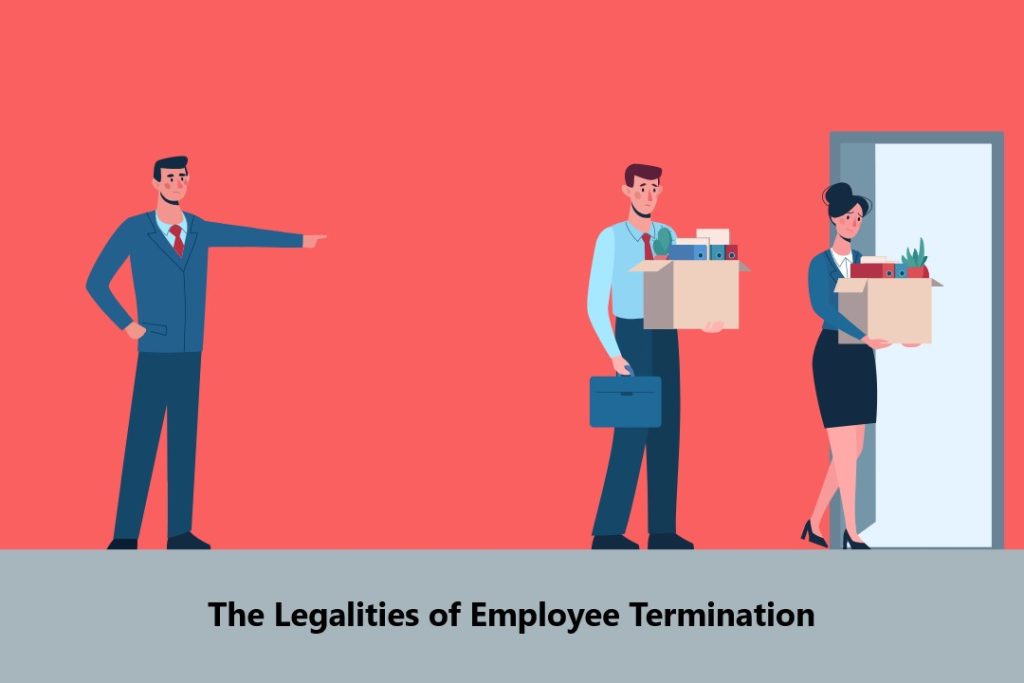Employee termination is one of the most challenging aspects of managing a business. The process can be emotionally charged and requires employers to carefully consider both legal and ethical factors. When handled improperly, employee terminations can lead to legal disputes, reputational damage, and financial liabilities for the company. Understanding the legalities of employee termination is essential for employers who wish to avoid legal complications and ensure a fair, compliant, and respectful process.
The legal framework governing employee terminations is complex, combining federal, state, and sometimes local laws that protect employees’ rights. Employers must ensure that their termination procedures adhere to these laws, which include anti-discrimination regulations, notice requirements, and wage payment rules. In this article, we will explore key legal aspects of employee termination, including at-will employment, wrongful termination claims, documentation, and best practices for reducing legal risks.
The Legalities of At-Will Employment
When considering the legalities of employee termination, most U.S. states follow the doctrine of at-will employment. This allows employers to terminate employees for any reason, or no reason, as long as it doesn’t violate federal or state law. This flexibility helps businesses adjust their workforce according to operational needs. However, despite this discretion, there are important exceptions that employers must follow to avoid wrongful termination claims.
Employees cannot be terminated for discriminatory reasons, as laws like the **Civil Rights Act of 1964**, the **Americans with Disabilities Act (ADA)**, and the **Age Discrimination in Employment Act (ADEA)** protect against discrimination. These laws safeguard employees from termination based on race, religion, gender, national origin, disability, age, and other protected characteristics. Employers who violate these protections risk lawsuits, fines, and reputational damage.
Additionally, some states have **good faith and fair dealing** provisions. These laws prevent employers from terminating employees in bad faith, such as to avoid paying bonuses or benefits. Even in at-will states, employers must be aware of these exceptions to avoid legal complications.
Wrongful Termination: Risks and Legal Claims
One of the most significant legal risks associated with employee termination is the possibility of a wrongful termination claim. Wrongful termination occurs when an employee is fired in violation of their legal rights. Common reasons for wrongful termination claims include discrimination, retaliation, and breaches of employment contracts.
For example, an employee who reports illegal activity within the company, such as safety violations or fraud, is protected by whistleblower laws. If an employer retaliates by firing the whistleblower, the employee has grounds for a wrongful termination claim. Similarly, an employee who takes FMLA leave (Family and Medical Leave Act) to care for a family member cannot be legally terminated for their absence.
To minimize the risk of wrongful termination claims, employers must ensure that terminations are based on documented performance issues or violations of company policy. Consistent documentation and adherence to established disciplinary procedures can provide a strong defense in the event of a legal challenge.
The Role of Documentation in Legal Compliance
Proper documentation is one of the most important tools employers have to protect themselves from legal liabilities during the termination process. When terminating an employee for performance issues or misconduct, employers must ensure that they have a clear record of the incidents leading to the termination. This includes written performance reviews, warnings, and any formal disciplinary actions taken.
Documentation serves multiple purposes. It provides a timeline of events that led to the termination, demonstrating that the decision was not arbitrary or discriminatory. It also helps defend the company in the event of a discrimination or retaliation claim. For example, if an employee in a protected class (such as someone over the age of 40) is terminated, well-documented performance issues can show that the termination was based on legitimate business reasons rather than discriminatory motives.
Additionally, employers should have clear termination policies in place that outline the steps to be followed when performance issues arise. These policies should include warnings, performance improvement plans (PIPs), and opportunities for employees to correct their behavior. Consistently applying these policies ensures that employers treat employees fairly and maintain transparency throughout the termination process.
Legalities Surrounding Final Pay and Benefits
The legalities of employee termination extend beyond simply ending the employment relationship. Employers must also comply with laws regarding final wages and benefits. Each state sets specific rules regarding when and how employers must issue final paychecks to terminated employees. For example, some states require that employees receive their final paycheck on their last day of work, while others allow for the next scheduled payday. Failure to adhere to these regulations can result in penalties and wage claims.
Employers should handle accrued benefits like vacation time, sick leave, or bonuses promptly. In many states, employers must pay employees for unused vacation time upon termination. Severance pay is another important consideration. While not legally required in most cases, severance packages can help reduce the risk of legal action by providing the terminated employee with financial support during their transition.
Additionally, terminated employees may qualify for continued health insurance coverage under COBRA (Consolidated Omnibus Budget Reconciliation Act). Employers must provide terminated employees with information about their right to continue their health insurance benefits and explain the process for doing so. Failure to comply with COBRA requirements can result in costly fines for the employer.
Best Practices for Conducting Terminations
When conducting a termination, it’s important to follow best practices that reduce the risk of legal disputes and maintain the dignity of the employee. First and foremost, conduct the termination meeting in a private setting to prevent embarrassment and maintain confidentiality. Employers should be clear, concise, and direct when explaining the reasons for the termination. Also, avoid discussing unrelated issues or making promises that you cannot keep during the termination process.
Employers should avoid terminating employees on the spot unless the situation involves gross misconduct. In most cases, employers should give employees prior warnings or place them on a performance improvement plan. This ensures that the employee is aware of the termination and demonstrates that the company acted fairly.
Additionally, employers should have a witness, such as an HR representative, present during the termination meeting. Having a witness during the termination meeting protects the company if the employee later claims improper or unfair handling.
Once the termination is complete, employers should immediately revoke the employee’s access to company systems, such as email, databases, and proprietary information. This helps prevent potential data breaches or misuse of company property. Employers should also arrange for the return of company equipment, such as laptops, phones, and access badges, to ensure a smooth transition.
Consulting Legal Counsel
Given the complexity of employment law, employers should consult an attorney before terminating an employee, especially when legal risks arise. Legal counsel ensures the termination complies with both federal and state laws, offering guidance for sensitive situations. Attorneys can review severance agreements, termination letters, and other documents to ensure legal accuracy and protection. In cases where litigation is possible, legal representation helps safeguard the company and minimize financial liabilities.
Understanding employee termination legalities helps businesses avoid disputes and maintain their reputation. At-will employment provides flexibility, but companies must still follow anti-discrimination laws and proper procedures. Documenting performance issues and consulting legal counsel ensures the process is compliant and respectful.
Terminating employees is difficult, but businesses can minimize risks by following the right steps and considering the legal implications. This approach helps maintain a positive work environment and avoid unnecessary legal complications.


